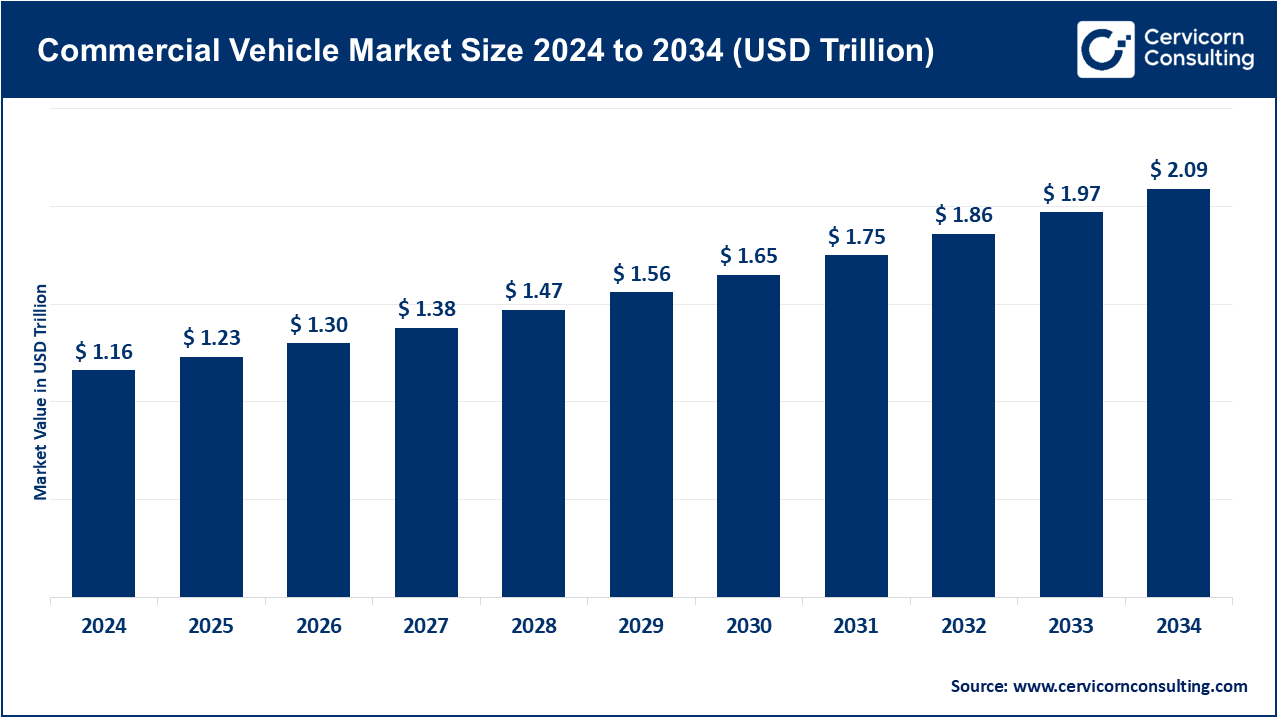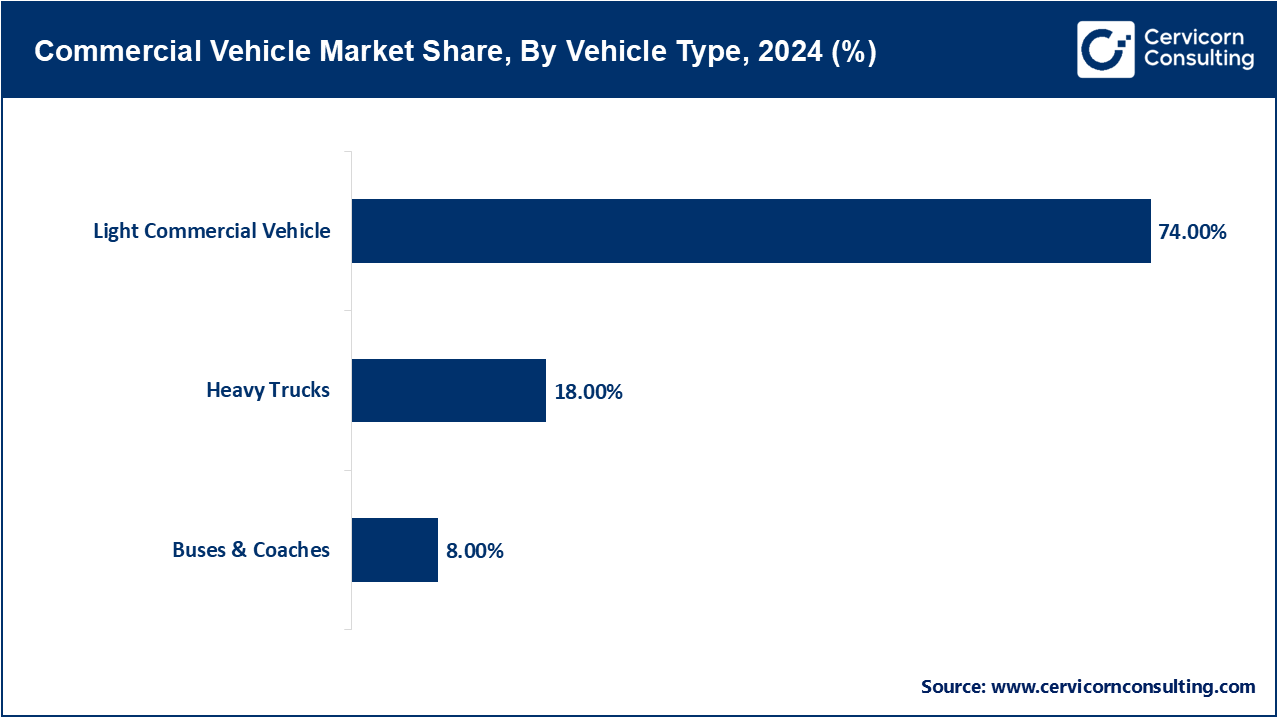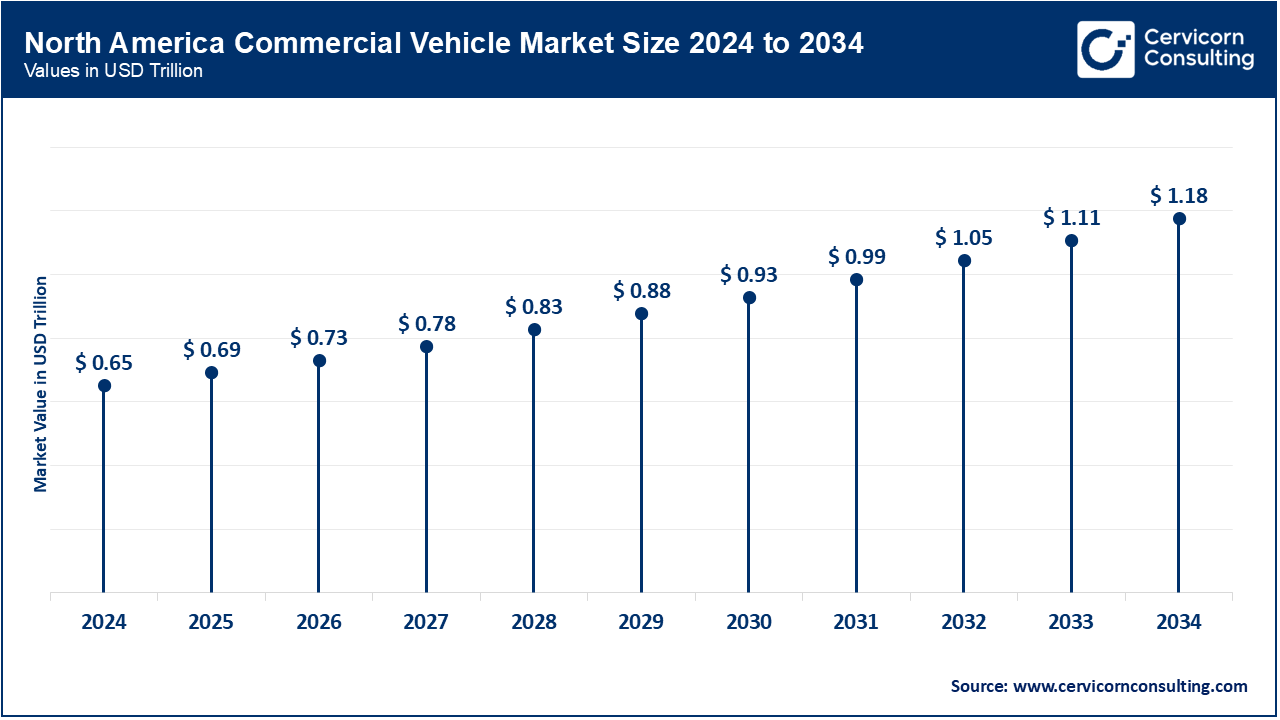The global commercial vehicle market size was valued at USD 1.16 trillion in 2024 and is expected to hit around USD 2.09 trillion by 2034, growing at a compound annual growth rate (CAGR) of 6.02% over the forecast period from 2025 to 2034. The commercial vehicle industry is changing quickly due to new technology and customer needs. Major manufacturers are focusing on creating better vehicle features, especially in connectivity, self-driving technology, and alternative engines. The increasing disposable income in both emerging and established nations, along with ongoing infrastructure expansion, is expected to positively impact market growth. The heightened awareness of environmentally friendly transportation options has encouraged commercial vehicle producers to create vehicles with lower carbon emissions. Manufacturers are focused on innovating vehicle designs, minimizing load factors and dimensions, and tailoring vehicles to comply with weight regulations.

In 2024, Asia-Oceania led worldwide motor vehicle manufacturing with 54.9 million units, accounting for more than half of total output. Europe produced 17.2 million units, closely behind America's 19.2 million. With 1.2 million units, Africa—apart from Egypt—contributed a rather small amount. The continuous dominance of Asia-Oceania is reflected in this distribution, especially because of important manufacturing nations like China, Japan, and South Korea, which are home to some of the biggest automakers in the world.
Motor Vehicle Production by Region, 2024
| Region | Units |
| Europe | 172,31,668 |
| America | 191,87,421 |
| Asia-Oceania | 549,07,849 |
| Africa (Excluding Egypt) | 11,77,400 |
Light Commercial Vehicle: The light commercial vehicle segment held highest revenue share. The growth of e-commerce and the need for flexible transportation in cities and towns make this segment important. These vehicles provide a good mix of payload capacity, manoeuvrability, and cost. This makes them particularly appealing to small and medium-sized businesses. Strong performance in this segment is also due to better fuel efficiency and the availability of electric options, which help reduce both operating costs and environmental impact.

Medium Commercial Vehicles: Medium commercial vans are essential for city deliveries and service businesses because they provide enclosed cargo space and are easy to maneuver in urban areas. These vans are increasingly using electric powertrains, making them suitable for zero-emission zones in cities. Medium-duty commercial trucks connect the light and heavy-duty segments and support regional distribution, construction, and specialized tasks. Both types of vehicles are embracing new technology, including advanced safety features, telematics, and alternative powertrains.
Heavy-duty Commercial Trucks: The heavy-duty commercial trucks segment is growing rapidly in the commercial vehicle market. This growth comes from more logistics operations and infrastructure projects worldwide. There are also more investments in electric and self-driving heavy-duty vehicles, as manufacturers focus on making them more efficient and environmentally friendly. This segment benefits from the increasing need for long-haul transportation and the rise of e-commerce, both of which require strong logistics networks. Additionally, advances in telematics, fleet management systems, and alternative fuel technologies are speeding up growth in this area. Government programs that support cleaner transportation and infrastructure projects create favorable conditions for the growth of heavy-duty commercial vehicles.
Passenger Transportation: Public transportation is becoming more popular, which is likely to increase the demand for commercial vehicles. In cities, public transportation is usually well-developed, and many people find it more efficient and cost-effective than driving a car. The easier access to and lower cost of passenger transport, combined with the rising costs of owning personal vehicles in both rich and developing countries, are important factors driving the demand for passenger transportation.
Logistics: The logistics segment has seen strong demand in recent years because of increased global trade. In 2024, this segment generated significant revenue due to the growth of e-commerce and retail. More consumers are choosing to shop online, which has helped the e-commerce sector expand and boosted the logistics market.
Commercial Vehicle Market Revenue Share, By End User, 2024 (%)
| End User | Revenue Share, 2024 (%) |
| Mining & Construction | 21% |
| Logistics | 28% |
| Passenger Transportation | 25% |
| Industrial | 16% |
| Others | 10% |
Mining & Construction: In order to deliver materials for expanding infrastructure projects like roads, bridges, and airports, a sizable fleet of commercial vehicles is needed. The heavy-duty vehicle market's adoption of battery technology is increasingly being driven by mining activities. By 2030, the Innovation for Cleaner, Safer Vehicles collaboration hopes to have zero-emission haul trucks on the road, which could result in a considerable reduction in emissions across about 28,000 high-payload vehicles. In order to lower noise and particulate pollution in sensitive locations, utilities and forestry fleets are also trying electric cars. This shows that customer needs differ greatly depending on the industry, location, and operational requirements.
Others: The market for commercial vehicles used in agriculture is growing quickly. This growth comes from more farmers using machines and employing precision farming techniques. Tractors are the most common type of vehicle in this market because they can be used for many different farming tasks. The demand for these vehicles is especially strong in the crop production area.
IC Engine: In 2024, internal combustion engines were the most popular choice in the medium and heavy commercial vehicle market. However, battery-electric trucks are growing quickly and are expected to continue this trend until 2030. This growth is supported by government subsidies, lower operating costs, and more urban fleets adopting electric vehicles. Internal combustion engines, especially diesel engines, are still the main power source for commercial vehicles because they provide strong torque and power for heavy-duty work. Manufacturers are investing in research to make internal combustion engines more fuel-efficient and produce fewer emissions. They are also exploring gas-based engines and those that use alternative fuels.
Commercial Vehicle Market Revenue Share, By Fuel Type, 2024 (%)
| Fuel Type | Revenue Share, 2024 (%) |
| IC Engine | 83% |
| Electric | 17% |
Electric: The electric vehicle (EV) market is expected to grow quickly because of rising demand and strict fuel economy regulations. To boost EV sales, manufacturers are focused on lowering battery prices, which will help the market expand. Commercial EVs are quieter than traditional gas-powered vehicles and do not produce air pollution. They also have a longer driving range and are better suited for self-driving technology. Therefore, the EV market is likely to see the highest growth rate during the forecast period.

North America has established markets where rules help standardize technology. California’s Advanced Clean Trucks rule affects purchasing plans nationally, as 11 other states are following its lead, representing about a quarter of the US Class 6-8 truck demand. Canada aims for 35% of truck sales to be zero-emission by 2030 and is funding charging stations along the Trans-Canada Highway. On the corporate side, Volvo and Daimler have teamed up to develop a shared operating system, while PACCAR is using its own battery packs to protect against market fluctuations.
By 2030, this region is likely to become even stronger because companies that make vehicles are setting up battery factories, software centers, and testing facilities close to their biggest customers. In 2024, China had over 90,000 registrations for electric heavy trucks, and companies like BYD and SAIC are sending kits to Hungary and Indonesia to avoid extra taxes. India has started 14 state programs that encourage places like Uttar Pradesh and Maharashtra to create low-emission areas that promote the use of 3.5-ton battery trucks. Additionally, the growth of industries like mining and logistics in developing countries in this region will help boost the market.
With new Euro VII requirements beginning in 2029, the EU intends to reduce CO2 emissions from large trucks by 45% by 2030. Electric vehicles (EVs) are replacing trucks powered by fossil fuels in many fleet operators. By 2021, 60% of operators desired electric or hybrid trucks, up from 40% in 2018. By 2025, operators anticipate that almost half of their fleets will be electric, and by 2030, they anticipate that 60% of the market would be made up of electric freight trucks. The expansion of the worldwide market will be aided by these developments.
Commercial Vehicle Market Revenue Share, By Region, 2024 (%)
| Region | Revenue Share, 2024 (%) |
| North America | 56.30% |
| Europe | 12.40% |
| Asia-Pacific | 25.30% |
| LAMEA | 6% |
The region is starting to attract more investments, even though it began with small amounts. It's growing quickly with an annual growth rate of 9.10%. Morocco and Egypt are ordering electric buses that use parts from medium-duty trucks, which helps create a supply base in the area. Ethiopia has already surpassed its goal for electric buses by 2030, showing the success of group buying methods. In South Africa, the EV White Paper outlines a plan that aims to improve fuel efficiency in current diesel vehicles while encouraging fast-charge stations near mining areas. These efforts indicate a strong demand for electric vehicles, which could lead to significant growth in shipments once the power grid gets more reliable.
The commercial vehicles industry is very competitive, with big companies trying hard to innovate and grow. They are focusing on creating electric and self-driving vehicles and are investing a lot in research to meet customer needs and follow new environmental rules. Being quick to adapt is important, so manufacturers are improving their production and supply chains to keep up with changes in the market. Partnerships, especially in battery technology and charging stations, are becoming important for growth. Companies are also opening new factories and distribution centres in different locations and are enhancing their after-sales service to keep customers happy and loyal.
Market Segmentation
By Vehicle Type
By Power Source
By Fuel Type
By End-user
By Region
Chapter 1. Market Introduction and Overview
1.1 Market Definition and Scope
1.1.1 Overview of Commercial Vehicle
1.1.2 Scope of the Study
1.1.3 Research Timeframe
1.2 Research Methodology and Approach
1.2.1 Methodology Overview
1.2.2 Data Sources and Validation
1.2.3 Key Assumptions and Limitations
Chapter 2. Executive Summary
2.1 Market Highlights and Snapshot
2.2 Key Insights by Segments
2.2.1 By Vehicle Type Overview
2.2.2 By Propulsion Type Overview
2.2.3 By Power Source Overview
2.2.4 By Fuel Type Overview
2.2.5 By End User Overview
2.3 Competitive Overview
Chapter 3. Global Impact Analysis
3.1 Russia-Ukraine Conflict: Global Market Implications
3.2 Regulatory and Policy Changes Impacting Global Markets
Chapter 4. Market Dynamics and Trends
4.1 Market Dynamics
4.1.1 Market Drivers
4.1.1.1 Sustainability and Environmental Responsibility
4.1.1.2 E-Commerce Boom Boosts Commercial Vehicle Sales
4.1.2 Market Restraints
4.1.2.1 High Operating Costs
4.1.2.2 Complexity in Operating Advanced Systems
4.1.3 Market Challenges
4.1.3.1 Economic Uncertainty
4.1.3.2 Regulatory Compliance
4.1.4 Market Opportunities
4.1.4.1 Reduce distribution costs and professionalize revenue management
4.1.4.2 Increasing incorporation of telematics and fleet management solutions
4.2 Market Trends
Chapter 5. Premium Insights and Analysis
5.1 Global Commercial Vehicle Market Dynamics, Impact Analysis
5.2 Porter’s Five Forces Analysis
5.2.1 Bargaining Power of Suppliers
5.2.2 Bargaining Power of Buyers
5.2.3 Threat of Substitute Products
5.2.4 Rivalry among Existing Firms
5.2.5 Threat of New Entrants
5.3 PESTEL Analysis
5.4 Value Chain Analysis
5.5 Product Pricing Analysis
5.6 Vendor Landscape
5.6.1 List of Buyers
5.6.2 List of Suppliers
Chapter 6. Commercial Vehicle Market, By Vehicle Type
6.1 Global Commercial Vehicle Market Snapshot, By Vehicle Type
6.1.1 Market Revenue (($Billion) and Growth Rate (%), 2022-2034
6.1.1.1 Light Commercial Vehicle
6.1.1.2 Buses & Coaches
6.1.1.3 Heavy Trucks
Chapter 7. Commercial Vehicle Market, By Propulsion Type
7.1 Global Commercial Vehicle Market Snapshot, By Propulsion Type
7.1.1 Market Revenue (($Billion) and Growth Rate (%), 2022-2034
7.1.1.1 IC Engine
7.1.1.2 Electric Vehicle
Chapter 8. Commercial Vehicle Market, By Power Source
8.1 Global Commercial Vehicle Market Snapshot, By Power Source
8.1.1 Market Revenue (($Billion) and Growth Rate (%), 2022-2034
8.1.1.1 Gasoline
8.1.1.2 Diesel
8.1.1.3 HEV / PHEV
8.1.1.4 Battery Electric Vehicle (BEV)
8.1.1.5 Fuel Cell Vehicle
8.1.1.6 LPG & Natural Gas
Chapter 9. Commercial Vehicle Market, By Fuel Type
9.1 Global Commercial Vehicle Market Snapshot, By Fuel Type
9.1.1 Market Revenue (($Billion) and Growth Rate (%), 2022-2034
9.1.1.1 IC Engine
9.1.1.2 Electirc
Chapter 10. Commercial Vehicle Market, By End-User
10.1 Global Commercial Vehicle Market Snapshot, By End-User
10.1.1 Market Revenue (($Billion) and Growth Rate (%), 2022-2034
10.1.1.1 Mining & Construction
10.1.1.2 Logistics
10.1.1.3 Passenger Transportation
10.1.1.4 Industrial
10.1.1.5 Others
Chapter 11. Commercial Vehicle Market, By Region
11.1 Overview
11.2 Commercial Vehicle Market Revenue Share, By Region 2024 (%)
11.3 Global Commercial Vehicle Market, By Region
11.3.1 Market Size and Forecast
11.4 North America
11.4.1 North America Commercial Vehicle Market Revenue, 2022-2034 ($Billion)
11.4.2 Market Size and Forecast
11.4.3 North America Commercial Vehicle Market, By Country
11.4.4 U.S.
11.4.4.1 U.S. Commercial Vehicle Market Revenue, 2022-2034 ($Billion)
11.4.4.2 Market Size and Forecast
11.4.4.3 U.S. Market Segmental Analysis
11.4.5 Canada
11.4.5.1 Canada Commercial Vehicle Market Revenue, 2022-2034 ($Billion)
11.4.5.2 Market Size and Forecast
11.4.5.3 Canada Market Segmental Analysis
11.4.6 Mexico
11.4.6.1 Mexico Commercial Vehicle Market Revenue, 2022-2034 ($Billion)
11.4.6.2 Market Size and Forecast
11.4.6.3 Mexico Market Segmental Analysis
11.5 Europe
11.5.1 Europe Commercial Vehicle Market Revenue, 2022-2034 ($Billion)
11.5.2 Market Size and Forecast
11.5.3 Europe Commercial Vehicle Market, By Country
11.5.4 UK
11.5.4.1 UK Commercial Vehicle Market Revenue, 2022-2034 ($Billion)
11.5.4.2 Market Size and Forecast
11.5.4.3 UKMarket Segmental Analysis
11.5.5 France
11.5.5.1 France Commercial Vehicle Market Revenue, 2022-2034 ($Billion)
11.5.5.2 Market Size and Forecast
11.5.5.3 FranceMarket Segmental Analysis
11.5.6 Germany
11.5.6.1 Germany Commercial Vehicle Market Revenue, 2022-2034 ($Billion)
11.5.6.2 Market Size and Forecast
11.5.6.3 GermanyMarket Segmental Analysis
11.5.7 Rest of Europe
11.5.7.1 Rest of Europe Commercial Vehicle Market Revenue, 2022-2034 ($Billion)
11.5.7.2 Market Size and Forecast
11.5.7.3 Rest of EuropeMarket Segmental Analysis
11.6 Asia Pacific
11.6.1 Asia Pacific Commercial Vehicle Market Revenue, 2022-2034 ($Billion)
11.6.2 Market Size and Forecast
11.6.3 Asia Pacific Commercial Vehicle Market, By Country
11.6.4 China
11.6.4.1 China Commercial Vehicle Market Revenue, 2022-2034 ($Billion)
11.6.4.2 Market Size and Forecast
11.6.4.3 ChinaMarket Segmental Analysis
11.6.5 Japan
11.6.5.1 Japan Commercial Vehicle Market Revenue, 2022-2034 ($Billion)
11.6.5.2 Market Size and Forecast
11.6.5.3 JapanMarket Segmental Analysis
11.6.6 India
11.6.6.1 India Commercial Vehicle Market Revenue, 2022-2034 ($Billion)
11.6.6.2 Market Size and Forecast
11.6.6.3 IndiaMarket Segmental Analysis
11.6.7 Australia
11.6.7.1 Australia Commercial Vehicle Market Revenue, 2022-2034 ($Billion)
11.6.7.2 Market Size and Forecast
11.6.7.3 AustraliaMarket Segmental Analysis
11.6.8 Rest of Asia Pacific
11.6.8.1 Rest of Asia Pacific Commercial Vehicle Market Revenue, 2022-2034 ($Billion)
11.6.8.2 Market Size and Forecast
11.6.8.3 Rest of Asia PacificMarket Segmental Analysis
11.7 LAMEA
11.7.1 LAMEA Commercial Vehicle Market Revenue, 2022-2034 ($Billion)
11.7.2 Market Size and Forecast
11.7.3 LAMEA Commercial Vehicle Market, By Country
11.7.4 GCC
11.7.4.1 GCC Commercial Vehicle Market Revenue, 2022-2034 ($Billion)
11.7.4.2 Market Size and Forecast
11.7.4.3 GCCMarket Segmental Analysis
11.7.5 Africa
11.7.5.1 Africa Commercial Vehicle Market Revenue, 2022-2034 ($Billion)
11.7.5.2 Market Size and Forecast
11.7.5.3 AfricaMarket Segmental Analysis
11.7.6 Brazil
11.7.6.1 Brazil Commercial Vehicle Market Revenue, 2022-2034 ($Billion)
11.7.6.2 Market Size and Forecast
11.7.6.3 BrazilMarket Segmental Analysis
11.7.7 Rest of LAMEA
11.7.7.1 Rest of LAMEA Commercial Vehicle Market Revenue, 2022-2034 ($Billion)
11.7.7.2 Market Size and Forecast
11.7.7.3 Rest of LAMEAMarket Segmental Analysis
Chapter 12. Competitive Landscape
12.1 Competitor Strategic Analysis
12.1.1 Top Player Positioning/Market Share Analysis
12.1.2 Top Winning Strategies, By Company, 2022-2024
12.1.3 Competitive Analysis By Revenue, 2022-2024
12.2 Recent Developments by the Market Contributors (2024)
Chapter 13. Company Profiles
13.1 Daimler Truck AG
13.1.1 Company Snapshot
13.1.2 Company and Business Overview
13.1.3 Financial KPIs
13.1.4 Product/Service Portfolio
13.1.5 Strategic Growth
13.1.6 Global Footprints
13.1.7 Recent Development
13.1.8 SWOT Analysis
13.2 Volvo Group
13.3 Traton SE (MAN, Scania, Navistar)
13.4 PACCAR Inc.
13.5 Tata Motors Ltd.
13.6 Hyundai Motor Co.
13.7 CNHTC (Sinotruk)
13.8 Dongfeng Motor Corp.
13.9 FAW Group
13.10 Renault Trucks
13.11 Isuzu Motors Ltd.